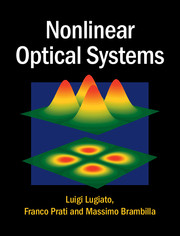Book contents
- Frontmatter
- Dedication
- Contents
- Preface
- Part I Models, propagation, stationary phenomena
- Part II Dynamical Phenomena, Instabilities, Chaos
- Part III Transverse optical patterns
- 26 Gaussian beams and modes of cavities with spherical mirrors
- 27 General features about optical pattern formation in planar cavities
- 28 The Lugiato-Lefever model
- 29 Spatial patterns in cavities with spherical mirrors
- 30 Cavity solitons
- Appendix A The Routh–Hurwitz stability criterion
- Appendix B Calculation of the oscillatory instability boundary
- Appendix C Coefficients of the characteristic equation (20.20)
- Appendix D Derivation of equations (20.27) and (20.28)
- Appendix E Coefficients of equations (20.60) and (20.61)
- Appendix F The exact boundary of the Risken–Nummedal–Graham–Haken instability
- Appendix G Nonlinear analysis of the roll solution
- References
- Index
28 - The Lugiato-Lefever model
from Part III - Transverse optical patterns
Published online by Cambridge University Press: 05 March 2015
- Frontmatter
- Dedication
- Contents
- Preface
- Part I Models, propagation, stationary phenomena
- Part II Dynamical Phenomena, Instabilities, Chaos
- Part III Transverse optical patterns
- 26 Gaussian beams and modes of cavities with spherical mirrors
- 27 General features about optical pattern formation in planar cavities
- 28 The Lugiato-Lefever model
- 29 Spatial patterns in cavities with spherical mirrors
- 30 Cavity solitons
- Appendix A The Routh–Hurwitz stability criterion
- Appendix B Calculation of the oscillatory instability boundary
- Appendix C Coefficients of the characteristic equation (20.20)
- Appendix D Derivation of equations (20.27) and (20.28)
- Appendix E Coefficients of equations (20.60) and (20.61)
- Appendix F The exact boundary of the Risken–Nummedal–Graham–Haken instability
- Appendix G Nonlinear analysis of the roll solution
- References
- Index
Summary
The equation (27.15) with FI independent of x and y was proposed in 1987 [307] with the purpose of formulating a model in the field of optics, that would be capable of producing a symmetry-breaking instability leading to the spontaneous formation of a two-dimensional stationary spatial pattern in an initially uniform system. Such instabilities had previously attracted considerable interest in chemistry and in developmental biology [91, 234, 235, 356], where they are commonly known as Turing instabilities [331]. In such fields they arise generally from the coupling between nonlinear chemical reactions and diffusion. Equation (27.15) provides a simple optical model in which analogous phenomena arise from the coupling between optical nonlinearities and diffraction in an optical cavity. This close analogy was made possible by the use of the low-transmission and single-longitudinal-mode limits, for the first time in a framework that included transverse effects.
Previous models [358] included also propagation and therefore involved all of the variables x, y, z and t in an exceedingly complex framework to identify an analogy with Turing instabilities in reaction-diffusion systems. The paradigmatic simplicity of Eq. (27.15), which arises from the presence of the simple Kerr nonlinearity, played a decisive role in promoting the field of optical pattern formation. Equation (27.15) has even been dubbed “the hydrogen atom” of nonlinear cavities [359], and is usually called the Lugiato–Lefever (LL) equation after the authors of [307].
Another basic feature that emerged from the introduction of Eq. (27.15) is the following. In plane-wave models, stationary instabilities arise for parametric values that are easily accessible experimentally (for example the laser threshold or the emergence of optical bistability), whereas dynamical instabilities of the kind described, for example, in Chapter 20, present rather restrictive parametric conditions (for instance, high instability thresholds or bad-cavity conditions). It turns out that stationary spatial pattern-forming instabilities arise under parametric conditions that are as easily accessible as those of plane-wave stationary instabilities.
- Type
- Chapter
- Information
- Nonlinear Optical Systems , pp. 363 - 377Publisher: Cambridge University PressPrint publication year: 2015
- 1
- Cited by



